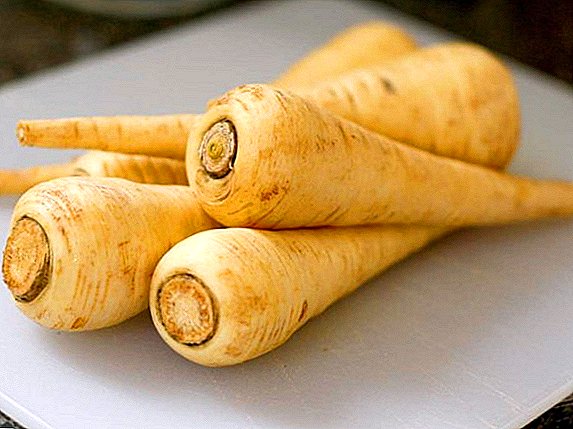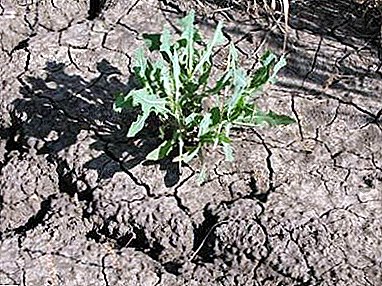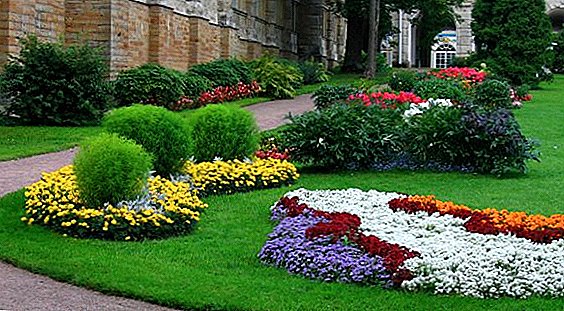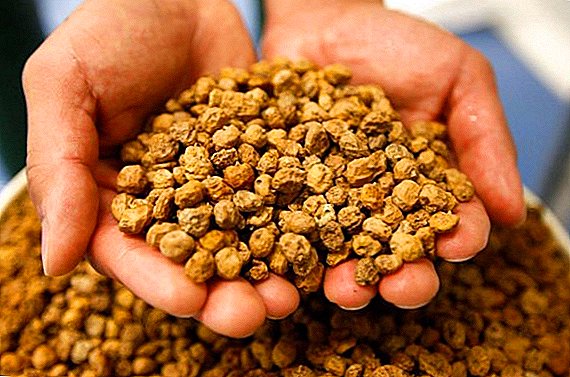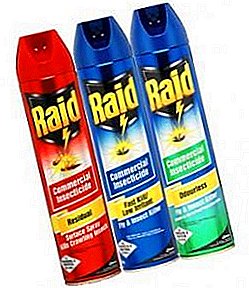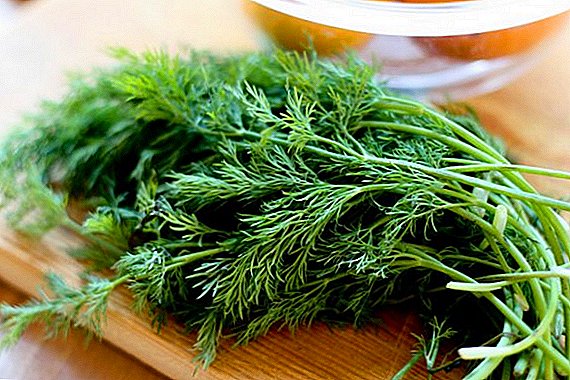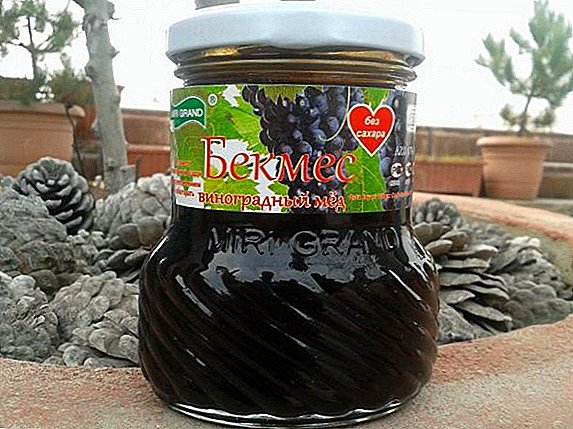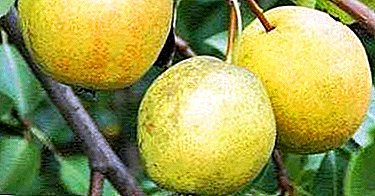
A beautiful female name Rogned named a dessert variety of pears that is very popular in the gardens near Moscow.
Few people know how tragic was the fate of the young Polotsk princess Rogneda, who fell into the millstones of political intrigues. It was not by chance that the plot became the basis of the libretto of the opera of the same name by A. Serov.
But the fruits of pear varieties do not resemble the historical drama - they turned out elegant, tasty and fragrant, like a young girl in the bright colors of summer.
Rogned Pear - description of the variety, photo of fruits, reviews and recommendations of gardeners later in the article.
Breeding history
Like many other popular pear varieties, the hybrid was created purposefully as winter-resistant for Central, North-West and Volga-Vyatka region in the Moscow Agricultural Academy. K.A. Timiryazeva.
Since 1987, he has been on trial trials, and in 2001 he was successfully included in the State Register and recommended for home gardens and industrial gardens, and as a promising material for breeding.
 Authoritative gardener among pomologov - Gennady Petrovich Rylov (the creator of the first in our country varietal nursery) qualified this variety of pears as one of the best for central Russia on a complex of inherited traits.
Authoritative gardener among pomologov - Gennady Petrovich Rylov (the creator of the first in our country varietal nursery) qualified this variety of pears as one of the best for central Russia on a complex of inherited traits.
And the main one is high winter hardiness, perceived in the third generation from the Ussuri pear and the species of folk selection that has taken root in the north of the Leningrad region - the Finnish yellow.
Excellent winter hardiness is also demonstrated: Orlovskaya Beauty, in memory of Zhegalov, Lyubimitsa Yakovleva, Talgar beauty and Tyoma.
Depending on the climatic zone in which it is cultivated, the Rognedu variety originators position themselves as:
- late summer;
- early autumn;
- autumn.
Her taste is attributed to "Rognedu" to dessert varieties, and good compatibility with quince (Ba-29) makes the process of replenishing the assortment of home gardens with a feasible task, even for a novice summer resident.
The most reliable in terms of survival are seedlings up to two years old: their root system is not injured when harvested in nurseries and is easier to adapt to a new place.
Hereditary symptoms
What hereditary features of "Rogneda" regarded GPRylov as advantages?
First of all:
- frost resistance and invulnerability to frost;
- complex resistance to the main types of diseases Rosaceae;
- early terms of entry into fruiting (for the 3rd year);
- original taste with notes of nutmeg;
- high yield (50 kg per tree);
- commodity attractiveness and good keeping quality of fruits (up to 2 months at low temperature);
- low demands on the agricultural background;
- breeding prospects.
Unpretentiousness can also boast: Bere Russkaya, Silent Don, Fairy Tale, Svarog and Larinskaya.
From the European parent "Rogneda" inherited shedding fruit when ripe. And in the process of sorting tests revealed another inherited quality: fruiting irregularity.
Pedigree of the new hybrid
The variety of Rogned pear, the description and photo of which will be lower, was created by crossing the existing varieties in several stages by pollination. The first, at the beginning of the 20th century, appeared in the Khabarovsk arctic nursery early autumn pear variety - "Tyoma".
 He secured a climatic endurance Ussuri pear and Baltic hybrid of national selection - "Finnish yellow". Along with it, 3 more child forms with similar characteristics were fixed: "Fields", "Olga" and "Lida".
He secured a climatic endurance Ussuri pear and Baltic hybrid of national selection - "Finnish yellow". Along with it, 3 more child forms with similar characteristics were fixed: "Fields", "Olga" and "Lida".
All new hybrids had the original (apple-like) roundness of fruitafter which the whole assortment of pears traditionally began to be divided into two groups (in the form of fruits):
- round ("lukashovki" - by the name of the breeder);
- blew (Old Russian name of pears, borrowed from the spoken Polish language).
So, one of Rogneda’s parents became proven over the years. ”Lukashov" - "Theme".
He handed over to the new hybrid:
- the shape of the fruit;
- the ability to grow and bear fruit in the northern regions of the European part of the country, Siberia and the Far East. In the Amur region it grows in the form of a stanza, which is very convenient during a snowy long winter;
- extended shelf life;
- high marketability of fruits;
- the ability to manifest during the flowering period of self-fertility (as an option).
 The second parent of Rogneda was I.V. Michurin's favorite breeding material - the Belgian variety. "Forest beauty", which has more than 30 subsidiary forms and an excellent rating of a variety of types.
The second parent of Rogneda was I.V. Michurin's favorite breeding material - the Belgian variety. "Forest beauty", which has more than 30 subsidiary forms and an excellent rating of a variety of types.
A proven European variety awarded a new hybrid:
- high yields for 15-20 years of reproductive age;
- outstanding consumer qualities;
- undemanding of soil composition and agrotechnical measures;
- drought tolerance;
- winter hardiness;
- durability.
Rogned variety description
- Based on the three definitions of fruit growth, the variety is more likely refers to medium strongi.e. his growth is within 10 meters. The tree structure is standard.
Crohn rounded, sometimes pyramidal, but not thick, due to the peculiarity of reduced growth of young shoots. The trunk and skeletal branches are gray-brown, smooth.
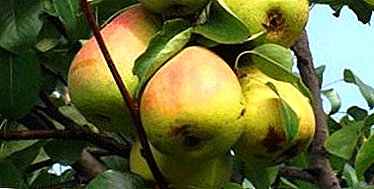 Young shoots are greenish-brown, fairly thick, slightly curved, slightly pubescent towards the ends. Fruiting provide young colants.
Young shoots are greenish-brown, fairly thick, slightly curved, slightly pubescent towards the ends. Fruiting provide young colants.- The species is characterized by vegetative and generative buds with visual differences in shape and size. The first one forms the leafy cover of the tree, the second - the self-infertile or self-fertile flowers.
- Variety "Rogneda" described in various sources as self-fertile and as needing additional pollination. Flower self-fertility depends on the height of stamens and their ability to pollinate. The sterility of pollen and the underdevelopment of the male organs of the flower is the path to self-infestation.
Pears “In memory of Anzin” and “Chizhovskaya” are recommended varieties that affect the fruitiness of the Rogneda flowers - they are generally recognized record-breaking winter hardiness having a common origin from breeding laboratories of the Moscow Agricultural Academy. K.A. Timiryazeva.
For a number of varieties of "Rogned" self-fertile and is itself a mandatory pollinator.
Important: For the effectiveness of fertilization of the ovary, pollinators should have the same timing of the flowering phase as the pollinated hybrid. Gardeners recommend for a full guarantee to have on the site up to 3 types of pears that differ in terms of ripening.
 Pear leaves - rich green, glossy, medium-sized, egg-shaped; bent along the midrib; edge have notched; fasten with a stem of medium thickness.
Pear leaves - rich green, glossy, medium-sized, egg-shaped; bent along the midrib; edge have notched; fasten with a stem of medium thickness.- Fruits are small, round (up to 120 gr.)They have a shiny smooth skin, rather dense, but easily bite through. The color of the fruit is complex: greenish-yellow with a blurred blush appearing at the time of maturity.
Numerous dark green dots shine through the fruit cover. Stony cells are not very noticeable when chewing.
The flesh is juicy, slightly oily, light beige, contains a large amount of fiber, sugars (7.5%) and a negligible amount of acids (0.1%), which makes the fruit taste exceptionally sweet.
Pears of this class are inherent light notes of nutmegthat gives them a specific aroma of southern congeners. Dessert fruit values are estimated at 4.1 points on the tasting scale.
- The tree enters the reproductive phase on the 3rd year of life.
- Fruits up to 20 years without strict regularity.
- Productivity by years fluctuates, sometimes reaching a maximum - 100 kg per tree. Therefore, in particularly productive years even recommended to remove up to 50% of the ovaries after a natural fall.
- Fruit ripening occurs to the beginning of August or his 3rd decade (exact dates depend on the cultivation region, where the variety is classified as late summer, early autumn or autumn).
- The variety has a hereditary tendency to falltherefore, harvesting is necessary until full consumer maturity. Mature fruits are stored for 1 week under normal conditions and 2 months - in the conditions of the refrigerating chamber.
 Pears of this variety are less affected by fungal diseases, showing resistance to scab and gray mold.
Pears of this variety are less affected by fungal diseases, showing resistance to scab and gray mold.- Severe winters during the trial period confirmed exceptional winter hardiness "Rognedy".
Varieties of pear are also distinguished by high yields: Tonkovetka, Sverdlovchanka, Samara Beauty, Bere Bosk and Tatiana.
Important: The pear is unpretentious, even heavy clay soils or sandstones can be suitable for it, the main thing is to timely feed the plant with organic matter.
A photo






Features of growing
- Pear does not tolerate transplants. Therefore, she needs to find once and for all a suitable place in the garden. In the southern regions of the heat-loving pear is usually picked sunny south side near the walls of buildings.
The hardy "Rogned" feels good and on the northeast or north side of the site, the main thing is that the early snow that covered the plant until spring did not become a standing swamp during melting (the pear does not like stagnant moisture).
Slow melting of the snow cover will save the pear from sunburn that threatens fruit trees at the end of winter. Ideally, it will do for her. elevated part of the garden, protected from constant winds.
- The technology of planting a pear is similar to the characteristics of planting an apple tree:

- the same dimensions of the pit (diameter 50cm, depth - 0.7m);
- planting a seedling on a mound of soil and humus;
- fortification on the north side;
- planting accuracy determined by the position of the root collar (5 cm above the edge of the pit);
- the formation of the root circle;
- watering;
- mulching with peat.
Tip: Regular feeding of seedlings begin from the moment of its entry into the fruiting phase (after 2-3 years).
- For the pear, all four components of the agro-complex of events are mandatory:
- watering (up to 5 times a month for a bucket in the morning and in the evening); of particular importance is watering during the period of fruit ripening and laying the buds of the future harvest; the amount of moisture is adjusted by weather conditions, the proximity of groundwater and the lingering growth of young shoots;
- trimming: when landing - on 1/3; annually before the opening of the kidneys; sanitary pruning of lying branches; thinning in order to leave strong shoots;
 top dressing (urea, ammonium nitrate, superphosphate, phosphate rock, potassium chloride, potassium sulfate, wood ash, ammophos, nitroammofoska) prescription dosage at the recommended time of the plant's vegetative cycle;
top dressing (urea, ammonium nitrate, superphosphate, phosphate rock, potassium chloride, potassium sulfate, wood ash, ammophos, nitroammofoska) prescription dosage at the recommended time of the plant's vegetative cycle;- spraying as a method of chemical control of parasites and pests, is carried out with the help of industrial pesticides and fungicides, as well as folk remedies (infusions, solutions, etc.).
Important: With any pruning can not exceed ¼ the mass of all branches!
- The crown of a pear increases annually by an average of 40 cm, so it’s important to provide for the future of its branches when planting a tree. Therefore, it is necessary to lay as a catering area for "Rogneda" 15 square meters of the garden. And if you plant trees in a row, then the interval to the neighboring trunk should be 4-5 meters.
Pear "Rogned" does not complicate, as you can see, your life, but will decorate the garden and will please the household. Among the unpretentious varieties also worth paying attention to the varieties: Krasnobakaya, Hera, Cathedral, Krasulia and Lada.


 Young shoots are greenish-brown, fairly thick, slightly curved, slightly pubescent towards the ends. Fruiting provide young colants.
Young shoots are greenish-brown, fairly thick, slightly curved, slightly pubescent towards the ends. Fruiting provide young colants. Pear leaves - rich green, glossy, medium-sized, egg-shaped; bent along the midrib; edge have notched; fasten with a stem of medium thickness.
Pear leaves - rich green, glossy, medium-sized, egg-shaped; bent along the midrib; edge have notched; fasten with a stem of medium thickness. Pears of this variety are less affected by fungal diseases, showing resistance to scab and gray mold.
Pears of this variety are less affected by fungal diseases, showing resistance to scab and gray mold.
 top dressing (urea, ammonium nitrate, superphosphate, phosphate rock, potassium chloride, potassium sulfate, wood ash, ammophos, nitroammofoska) prescription dosage at the recommended time of the plant's vegetative cycle;
top dressing (urea, ammonium nitrate, superphosphate, phosphate rock, potassium chloride, potassium sulfate, wood ash, ammophos, nitroammofoska) prescription dosage at the recommended time of the plant's vegetative cycle;